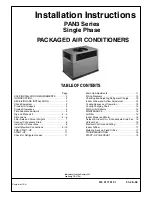
11
PRE--START--UP
FIRE, EXPLOSION, ELECTRICAL SHOCK HAZARD
Failure to follow this warning could result in personal
injury or death.
1. Follow recognized safety practices and wear
protective goggles when checking or servicing
refrigerant system.
2. Relieve and recover all refrigerant from system
before touching or disturbing anything inside
terminal box if refrigerant leak is suspected around
compressor terminals.
3. Never attempt to repair soldered connection while
refrigerant system is under pressure.
4. Do not use torch to remove any component. System
contains oil and refrigerant under pressure.
5. To remove a component, wear protective goggles
and proceed as follows:
a. Shut off electrical power to unit and install
lockout tag.
b. Relieve and reclaim all refrigerant from
system using both high-- and low--pressure
ports.
c. Cut component connecting tubing with tubing
cutter and remove component from unit.
d. Carefully unsweat remaining tubing stubs
when necessary. Oil can ignite when exposed
to torch flame.
!
WARNING
Use the Start--Up Checklist supplied at the end of this book
and proceed as follows to inspect and prepare the unit for
initial start--up:
1. Remove access panel.
2. Read and follow instructions on all DANGER,
WARNING, CAUTION, and INFORMATION labels
attached to, or shipped with unit.
3. Make the following inspections:
a.
Inspect for shipping and handling damage, such as
broken lines, loose parts, disconnected wires, etc.
b.
Inspect for oil at all refrigerant tubing connections
and on unit base. Detecting oil generally indicates
a refrigerant leak.
c.
Leak--test all refrigerant tubing connections using
electronic leak detector, or liquid--soap solution. If
a refrigerant leak is detected, see following Check
for Refrigerant Leaks section.
d.
Inspect all field-- and factory--wiring connections.
Be sure that connections are completed and tight.
e.
Ensure wires do not touch refrigerant tubing or
sharp sheet metal edges.
f.
Inspect coil fins. If damaged during shipping and
handling, carefully straighten fins with a fin comb.
4. Verify the following conditions:
a.
Make sure that condenser--fan blade is correctly
positioned in fan orifice. Top 1/3 of condenser--fan
blade should be within fan orifice venturi.
b.
Make sure that condensate drain pan and trap are
filled with water to ensure proper drainage.
c.
Make sure that all tools and miscellaneous loose
parts have been removed.
FIGURE 10
Fan Blade Clearance
FAN GRILLE
MOTOR
1/8" MAX BETWEEN
MOTOR AND FAN HUB
MOTOR SHAFT
1/2ý
START--UP
Step 1—CHECK FOR REFRIGERANT LEAKS
Proceed as follows to locate and repair a refrigerant leak
and to charge the unit:
1. Locate leak and make sure that refrigerant system
pressure has been relieved and reclaimed from both
high-- and low--pressure ports.
2. Repair leak following accepted practices.
NOTE
: Install a filter drier whenever the system has been
opened for repair.
3. Add a small charge of R--22 refrigerant vapor to system
and leak--test unit.
4. Recover refrigerant from refrigerant system and
evacuate to 500 microns if no additional leaks are
found.
5. Charge unit with R--22 refrigerant, using a volumetric
charging cylinder or accurate scale. Refer to unit rating
plate for required charge. Be sure to add extra
refrigerant to compensate for internal volume of filter
drier.
STEP 2—START--UP ADJUSTMENTS
Complete the required procedures given in the
Pre--Start--Up section before starting the unit. Do not
jumper any safety devices when operating the unit. Do not
operate the unit in cooling mode when the outdoor
temperature is below 40
°
F (unless accessory low--ambient
kit is installed). Do not rapid cycle the compressor. Allow 5
min. between “on” cycles to prevent compressor damage.
CHECK COOLING CONTROL
Start and check the unit for proper cooling operation as
follows:
1. Place room thermostat SYSTEM switch in OFF
position. Observe that blower motor starts when FAN
switch is placed in ON position and shuts down within
60 sec. when FAN switch is placed in AUTO position.
2. Place SYSTEM switch in COOL position and FAN
switch in AUTO position. Set control below room
temperature. Observe that cooling cycle shuts down
when control setting is satisfied.



















